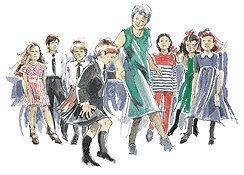Poland is a nation rich in culture, and musical tradition. In fact, Poland even has five (5) National Dances. There are few countries in the world that have even one national dance.
Brazil has the Samba, Argentina the Tango, Cuba has the Rumba, and Ukraine has the Hopak. Haiti and the Dominican Republic share the Merengue as a national dance. Several Middle Eastern countries share the Dabke. Other than Poland, it is only Columbia that has more than one dance: the Cumbia and the Vallenate.
The U.S.A. on the other hand, does not have a national dance, however about half of the states have a State Dance, and most of them claim the Square Dance, though Hawaii has the Hula, and South Carolina has the Shag. Plus, in a tradition of east versus west, California has the West Coast Swing (in addition to the Square Dance), while New York has the Lindy Hop (also known as Eastern Swing). Wisconsin and Pennsylvania both claim the Polka.
Which leads us back to Poland. No, the Polka is not a national dance of Poland. Poland’s national dances are: The Krakowiak, the Mazur (Mazurka), Polonez (Polonaise), the Kujawiak, and the Oberek. These dances, which originated in the Polish countryside, were so popular that they found their way to the royal court, and were even incorporated into classical works by composers like Chopin.
.The Polonez, or Poland Dance of 18th century nobility, has its roots in the 17th century walking dance Chodzony, which traditionally opened up balls and weddings in country villages throughout Poland.
Danced to a slow 3/4 tempo, the partners do not face each other, but rather walk to the music around the ballroom… forward, back, side, often bowing, but always maintaining a formal, stately posture.
While the Polonez may be danced wearing a folk costume from any of Poland’s ethnographic regions, it is usually performed with the dancers dressed in Kontusze, the costume of the Polish Nobility of the 17th century.
The Polonez is still danced in Poland today as the opening procession for student Proms.
In addition to the dance, the Polonaise music is often the basis for Polish Christmas carols, Kolędy.
The Mazur originated in the Mazowsze region of central Poland in the 16th century, and by the 17th century was danced in villages throughout Poland.

With its quick 3/4 tempo…accented on the 2nd or 3rd beat, and intricate steps…heel clicking, slides, and running steps, it soon found its way to the Polish Court.
As a result, you will often find the Mazur danced in different ways to different types of music, from the delicate Mazur of the peasants (in regional folk costumes), to the military style Mazur of the Uhlans (soldiers in uniform, ladies in ball gowns).
The Mazur also found its way into operas, like this one from the Polish Opera Halka by famed composer Stanisław Moniuszko. It is an example of a military Mazur. (The costumes are Kontusze.)
The Mazur is also popular in ballets, like this mazurka from the French ballet, Coppelia by Leo Delibes. Even though it is in ballet form, it has all the elements of the peasant Mazur.
So popular is the Mazur in Poland that most of that country’s patriotic songs have a Mazur tempo, including the National Anthem ! (otherwise known as Mazurek Dąbrowskiego).
.
The Krakowiak originated in the southern Polish city of Kraków, Poland’s capital in the 16th century.

Known as the Polish dance, the Krakowiak has a 2/4 timing, and is danced in groups, often forming intricate formations, like stars. The steps include shuffling, running, and heel clicking.
The costume of Kraków is the one that is most identified with Poland.
While the Krakowiak was a popular ballroom dance in Austria and France in the mid 19th century, it is not danced socially today. American Polka bands, however, often take Krakowiaks and turn them into Polkas.
.
The Kujawiak originated in the Kujawy region of North-Central Poland in the 19th century, and was quickly embraced by the gentry because of its dignified simplicity.
With a 3/4 tempo that alternates between very slow, and fast, the Kujawiak went through many incarnations as it passed back and forth between the peasants and the nobility, each group adding to the style of the dance. It features spinning turns and elaborate gestures, and is usually danced in a circle.
The costume worn by the dancers is that of the Kujawy region.
Here are the Polish Tenors with their rendition of a Kujawiak at a recent Przystanek Woodstock performance.
.
The Oberek originated in the Mazowsze region of central Poland in the 17th century, and was played by small village bands dominated by the violin, along with an accordion or bass, and a drum.

With its quick tempo, 3/4 timing it soon became popular in almost all of the regions of Poland. The Oberek is a lively dance with turns and twirls, and the occasional lifting of both women and men.
Folk costumes from many regions of Poland are associated with the Oberek, though the Łowicki costume is favored by many dance troupes.
The Oberek is still performed socially, especially in North America, though without the lifts.
The Moral of the Story is that musical tradition is such a significant part of Poland’s heritage that it warrants Five (5) National Dances !!
|



 Around 400 AD, after the conversion to Christianity, the new priests used the pagan style of ornamentation in illuminating their manuscripts, while the peasants retained the same qualities in their music and dancing.
Around 400 AD, after the conversion to Christianity, the new priests used the pagan style of ornamentation in illuminating their manuscripts, while the peasants retained the same qualities in their music and dancing. to the court of Queen Elizabeth. One of these dances was the Trenchmore, which was an adaptation of an old Irish peasant dance. From this period onward another style of dance called the Hey was popular where female dancers wound in around their partners, in a fore-runner of the present day reel.
to the court of Queen Elizabeth. One of these dances was the Trenchmore, which was an adaptation of an old Irish peasant dance. From this period onward another style of dance called the Hey was popular where female dancers wound in around their partners, in a fore-runner of the present day reel. When dancing masters met at fairs, they challenged each other to a public dancing contest that only ended when one of them dropped with fatigue.
When dancing masters met at fairs, they challenged each other to a public dancing contest that only ended when one of them dropped with fatigue.